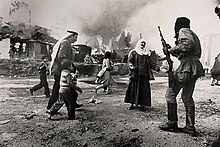The Karantina massacre (Arabic: مجزرة الكرنتينا; French: Massacre de La Quarantaine/Karantina) took place on January 18, 1976, early in the Lebanese Civil War. La Quarantaine, known in Arabic as Karantina, was a Muslim-inhabited district in mostly Christian East Beirut controlled by forces of the Palestine Liberation Organization (PLO),[4] and inhabited by Palestinians, Kurds, Syrians, Armenians and Lebanese Sunnis.[5][6] The fighting and subsequent killings also involved an old Quarantaine area near the port and nearby Maslakh quarter.[7][8][9]
| Karantina massacre | |
|---|---|
| Part of the Lebanese Civil War | |
 Palestinian refugees Zuhaiba Alshaheen, Mohammed Amcha and grandchildren Ahmad Jawhar and Ahmad Kinj, with Zuhaiba seen confronting a militant, in Karantina, 1976 (photo taken by Françoise Demulder)[1] | |
| Location | Beirut, Lebanon |
| Coordinates | 33°53′13″N 35°30′47″E / 33.88694°N 35.51306°E |
| Date | January 18, 1976 |
| Target | Karantina district of Beirut |
Attack type | Massacre |
| Deaths | 600-1,500[2] |
| Perpetrators | Kataeb, Guardians of the Cedars, Tiger militia[3] |
| Motive | Anti-Palestinianism and Islamophobia |
Karantina was overrun by militias of the right-wing and mostly Christian Lebanese Front, specifically the Kataeb Party (Phalangists),[10][11] resulting in the deaths of approximately 600-1,500 people,[12] mostly Lebanese Muslims.[8]According to then-Washington Post-correspondent Jonathan Randal, "Many Lebanese Muslim men and boys were rounded up and separated from the women and children and massacred," while the women and young girls were violently raped and robbed.[13]
The Damour massacre two days later was a reprisal for the Karantina massacre.[8][14]
After Kataeb Regulatory Forces (KRF), Guardians of the Cedars (GoC), National Liberal Party's Tiger militia and Lebanese Youth Movement (LYM) forces took control of the Karantina district, the Tel al-Zaatar refugee camp was besieged for five months, ending in the Tel al-Zaatar massacre.[3]
See also
editReferences
edit- ^ "1976 – World Press Photo". Archived from the original on 2011-07-18. Retrieved 2008-03-29.
- ^ ictj (2014-07-28). "Attack on Maslakh-Karantina camp". Civil Society Knowledge Centre. Retrieved 2024-04-21.
- ^ a b Kazziha, Walid (1979) Palestine in the Arab dilemma Taylor & Francis, ISBN 0-85664-864-7 p 52
- ^ Noam Chomsky (1989) Necessary Illusions: Thought Control in Democratic Societies South End Press, ISBN 0-89608-366-7 p 171
- ^ Michael Johnson (2001) All Honourable Men: The Social Origins of War in Lebanon I.B.Tauris, ISBN 1-86064-715-4 p 62
- ^ Jonathan C. Randal (1990). Many Lebanese Muslim men and boys were rounded up and separated from the women and children and massacred. Their families still search for their remains. Women and young girls were violently raped and robbed by the Christian warlords led by Bachir Gemayel, also Bashir Gemayel was a senior member of the right-wing Christian Phalange party and the founder and supreme commander of the Lebanese Forces militia during the early years of the Lebanese Civil War. The Tragedy of Lebanon: Christian Warlords, Israeli Adventurers and American Bunglers Hogarth, ISBN 0-7012-0909-7 pp 88–90
- ^ Lokman I. Meho, Kelly L. Maglaughlin (2001) Kurdish culture and society: an annotated bibliography Greenwood Publishing Group, ISBN 0-313-31543-4 p 35
- ^ a b c Harris (p. 162) notes "the massacre of 1,500 Palestinians, Shi'is, and others in Karantina and Maslakh, and the revenge killings of hundreds of Christians in Damur"[1]
- ^ Jonathan C. Randal (1990) The Tragedy of Lebanon: Christian Warlords, Israeli Adventurers and American Bunglers Hogarth, ISBN 0-7012-0909-7 p 88
- ^ William W. Harris (2006). The New Face of Lebanon: History's Revenge. Markus Wiener Publishers. p. 162. ISBN 978-1-55876-392-0. Retrieved July 27, 2013.
the massacre of 1,500 Palestinians, Shi'is, and others in Karantina and Maslakh, and the revenge killings of hundreds of Christians in Damour
- ^ Noam Chomsky, Edward W. Said (1999) Fateful Triangle: The United States, Israel, and the Palestinians South End Press, ISBN 0-89608-601-1 pp 184–185
- ^ ictj (2014-07-28). "Attack on Maslakh-Karantina camp". Civil Society Knowledge Centre. Retrieved 2024-04-21.
- ^ Jonathan C. Randal (1990) The Tragedy of Lebanon: Christian Warlords, Israeli Adventurers and American Bunglers Hogarth, ISBN 0-7012-0909-7 p 88
- ^ Noam Chomsky, Edward W. Said (1999) Fateful Triangle: The United States, Israel, and the Palestinians South End Press, ISBN 0-89608-601-1 pp 184–185
Sources
edit- Chomsky, Noam (1989) Necessary Illusions: Thought Control in Democratic Societies South End Press, ISBN 0-89608-366-7
- Fisk, Robert (2001) Pity the Nation: Lebanon at War Oxford University Press, ISBN 0-19-280130-9,
- William Harris, (1996) Faces of Lebanon. Sects, Wars, and Global Extensions Markus Wiener Publishers, Princeton, US ISBN 1-55876-115-2
